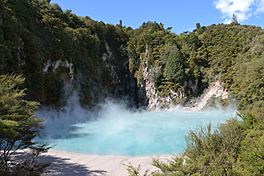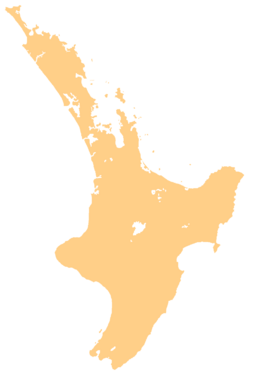Inferno Crater Lake facts for kids
Quick facts for kids Inferno Crater Lake |
|
|---|---|

Inferno Crater Lake at high lake level
|
|
| Location | Waimangu Volcanic Rift Valley, North Island |
| Coordinates | 38°16′55″S 176°23′59″E / 38.28194°S 176.39972°E |
| Primary inflows | (underwater geyser) |
| Primary outflows | cyclic overflow into Waimangu Stream |
| Basin countries | New Zealand |
| Average depth | 22 to 30 m (72 to 98 ft) |
| Max. depth | 30 m (98 ft) |
Inferno Crater Lake is a huge hot spring found in the Waimangu Volcanic Rift Valley on New Zealand's North Island. It is known as the biggest geyser-like feature in the world. The actual geyser is hidden underwater at the bottom of the lake. However, you can see steam vents, called fumaroles, on the lake's edge and the rock wall behind it.
The lake's water can be very hot, from 35 to 80 degrees Celsius. It is also very acidic, like lemon juice, with a pH of 2.2. The water level changes a lot, up to 12 meters, following a special 38-day pattern.
Contents
Inferno Crater Lake
What Makes It Special?
The lake's color changes depending on its water level. When the water is low, it can look dull grey. But when the water level is high, especially after it overflows, it turns a bright sky blue! This color comes from tiny bits of a mineral called silica floating in the water. White silica deposits also build up around the lake's edges.
How Inferno Crater Formed
Inferno Crater was created during a huge volcanic eruption in 1886. This eruption blasted a hole in the side of a mountain called Mt Haszard. The eruption also opened up many other craters along a 17-kilometer line.
The lake bed of Inferno Crater is shaped like a trumpet. It can be up to 30 meters deep when the lake is full. This is also when the water reaches its highest temperature.
The Amazing Water Cycle
Since 1901, the water level in Inferno Crater Lake has been linked to another nearby geyser, the Waimangu Geyser. Inferno Crater Lake and its neighbor, Frying Pan Lake, have a unique connection. They follow a rhythmic cycle of water changes that repeats every 38 days.
When Inferno Crater Lake's water level and temperature go up, Frying Pan Lake's water level and outflow go down. This kind of connected cycle is very rare and not seen in other hot spring systems around the world.
Scientists have been studying this system since 1970. They have found four main parts to its cycle:
- Phase 1: Rising Water The lake level slowly rises by almost 5 meters over eight days.
- Phase 2: Oscillating Water The water level then starts to go up and down, but the average level keeps rising until the lake is full. At this point, the lake has gained a lot of water.
- Phase 3: Overflow The lake then overflows for about 51 hours. Hot water, over 70 degrees Celsius, flows down into the Waimangu Stream below.
- Phase 4: Receding Water Finally, the lake level drops back to its lowest point over the next 13 days. The water temperature also falls during this time.
Visiting Inferno Crater Lake
You can visit Inferno Crater Lake by taking a side path from the main Waimangu walking track. There are 50 steps leading down to the lake. It is one of three lakes that fill craters made during the big 1886 eruption.
See also
 In Spanish: Lago del cráter del infierno para niños
In Spanish: Lago del cráter del infierno para niños


